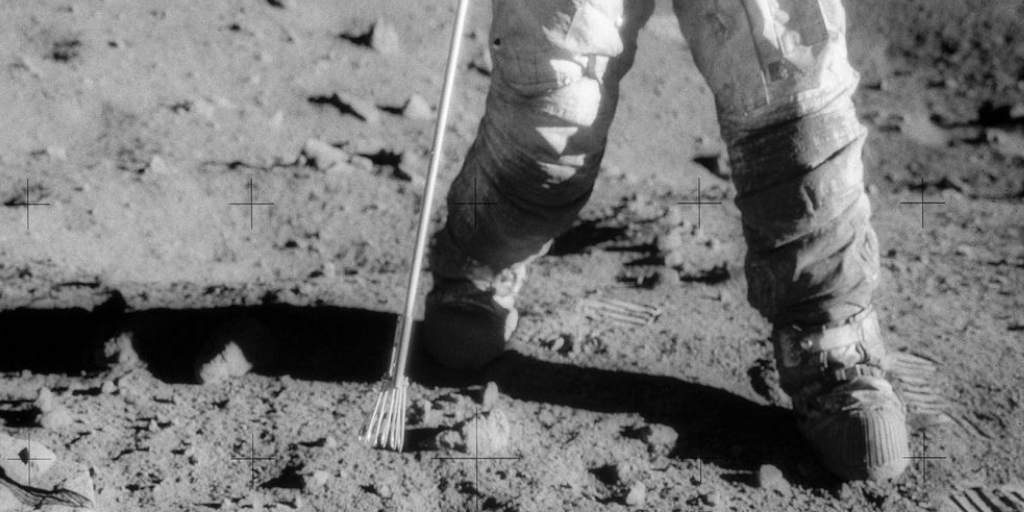From the Apollo era, it is known that dust on the Moon can cause serious problems for exploration activities. Such problems include adhering to clothing and equipment, reducing external visibility on landings, and causing difficulty breathing and vision within the spacecraft.
As NASA is preparing to send humans back to the Moon under the Artemis Program, a major concern is the impact of lunar dust on the human exploration of the Moon. In their flights to Moon from 1969-1972, the Apollo astronauts experienced numerous problems with lunar dust. Lunar dust blew up into the thin lunar atmosphere during the landing of the Lunar Module significantly impacted astronaut visibility. On the lunar surface, lunar dust kicked up by the astronauts walking and driving their lunar rover had deleterious effects on their spacesuits and helmets and surface equipment and instrumentation. The tiny, very sharp, glassy lunar dust particles eroded and deteriorated their spacesuits and their seals. On the flight back to Earth, free-floating lunar dust in the Command Module caused additional problems.
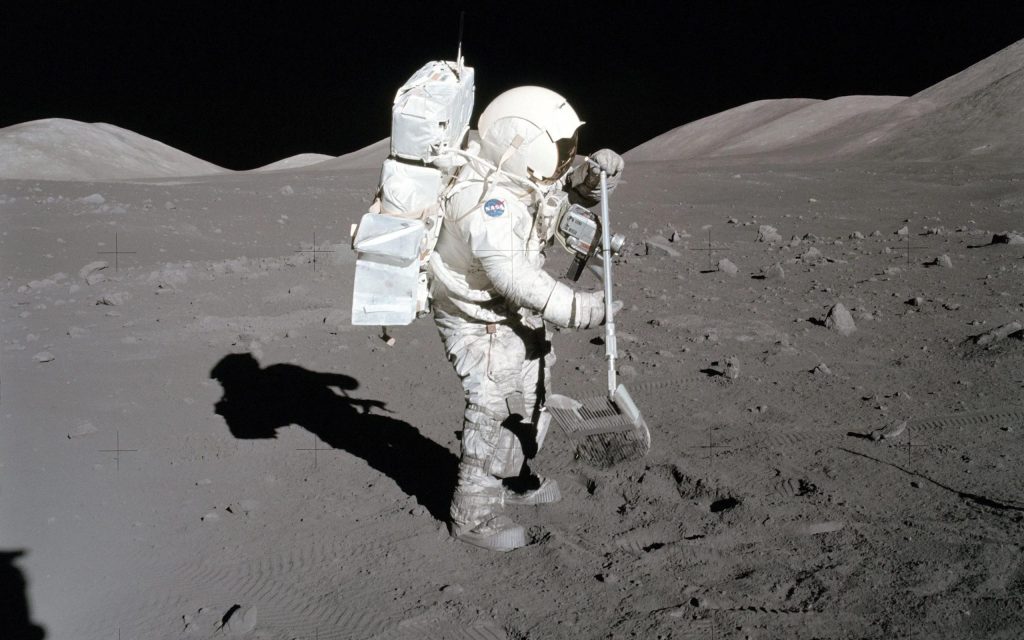
Credit: NASA
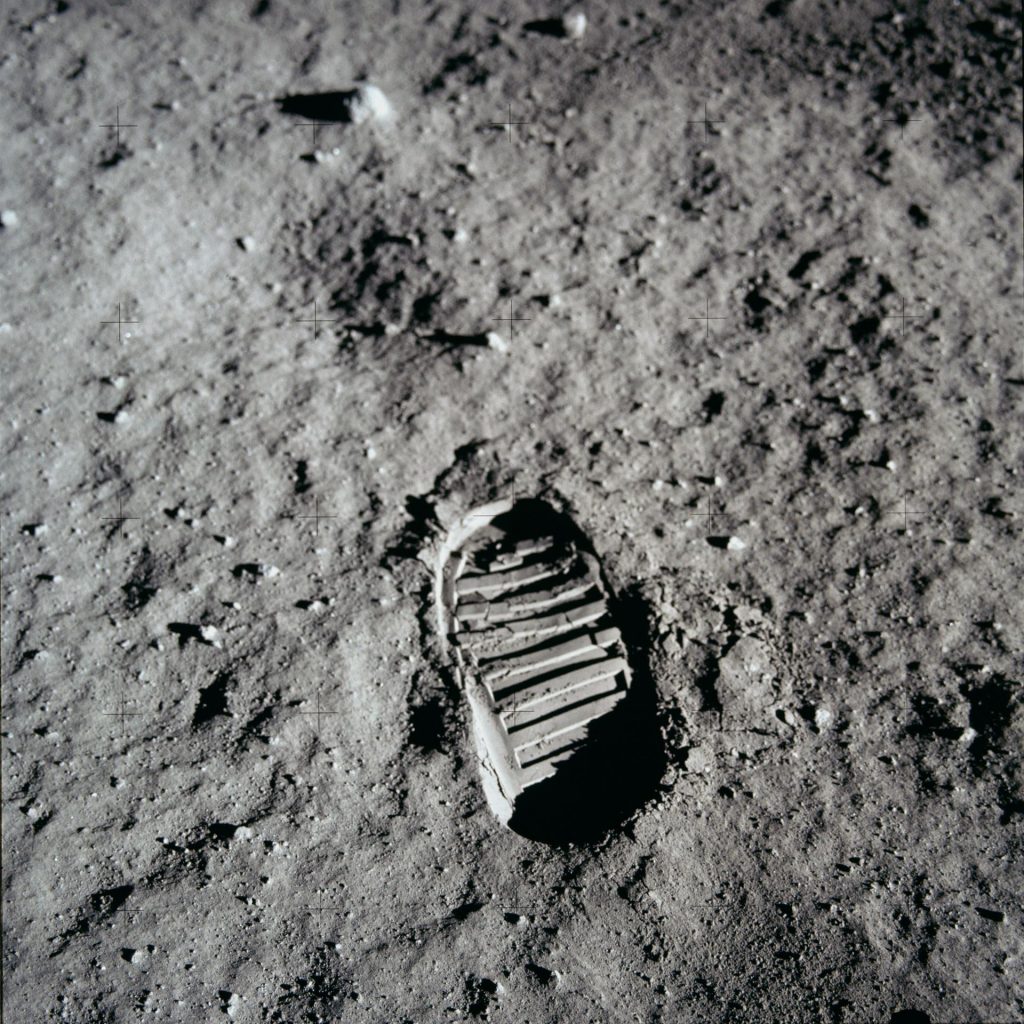
Credits: NASA
Lunar dust is one of the principal issues cited in returning to the Moon. Lunar dust is difficult to remove or mitigate as it is extremely abrasive, highly cohesive, electrically charged, and small in size (~50 – 0.1 μm). In addition to threatening astronaut health, lunar dust issues have also resulted in wrong instrument readings, vision/optical system obscuration, performance reduction, altered thermal properties, and equipment failure, among others.
NASA has recognized dust mitigation as being a priority in its Requirements for the Robotic Lunar Exploration Program (RLEP) document (ESMD-RQ-0014), which states that the potential biological impacts of the lunar environment, including the micrometeoroid and dust environments, will be investigated (RLEP-M20 and RLEP-T20). The dust has also been highlighted as a priority by the Mars Exploration Program Analysis Group (MEPAG). An important step in dealing with dust-related problems is to understand how dust grains behave in the ambient lunar environment. This will require both advances in our theoretical understanding together with a thorough characterization of the near-surface dust-plasma environment with comprehensive in-situ observations.
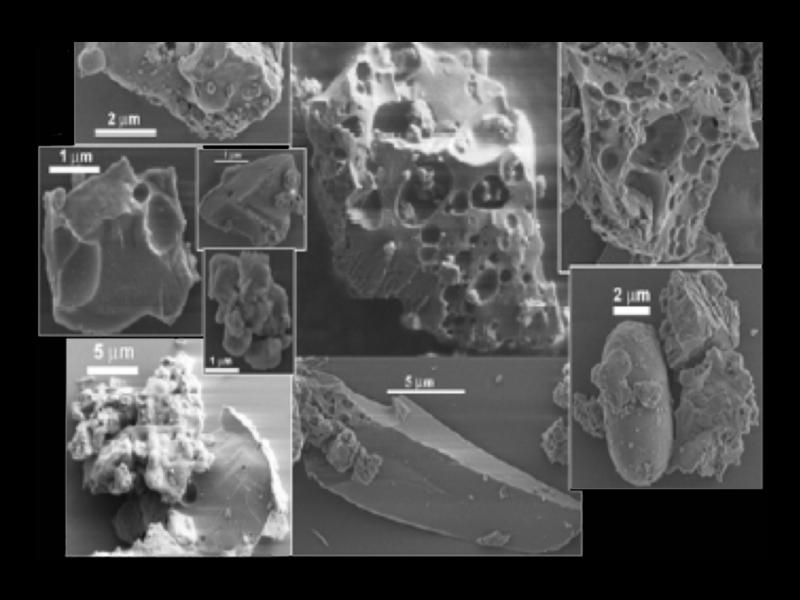
Credit: NASA
Properties of Lunar Dust
“Lunar regolith” describes the layer of particles on the Moon’s surface generated by meteoritic impacts, and is similar to terrestrial volcanic ash. The finest component is referred to as dust (<100 µm). The average regolith grain size is ~70µm, (too fine to see with the human eye), with roughly 10 to 20% by weight <20µm.
The low electrical conductivity of the regolith allows individual dust grains to retain an electrostatic charge. On the dayside conductivity can increase with surface temperature and infrared and ultra-violet radiation; therefore, this needs to be taken into account for surface and dust charging processes.
Over billions of years, the lunar regolith has been constantly bombarded by micrometeoroids. The Moon is continually bombarded by on the order of 106 kg/y of interplanetary dust particles (IDP) of cometary and asteroidal origin. Most of these projectiles range from 10 nm to about 1 mm in size and impact the Moon with speeds in the range of 10 to 72 km/s. On Earth, the entry and traverse of these projectiles are referred to as “shooting stars.” When the micrometeoroids hit the lunar surface regolith, they create a miniature shockwave in the soil, which causes some of the soil to melt and form secondary ejecta particles and some to vaporize to a gas. The molten soil immediately freezes again forming tiny pieces of glass—glass shards. These tiny glass shards are jagged and very sharp. Most of the ejecta particles have initial speeds below the escape velocity of the Moon (2.4 km/s) and they return to the lunar surface, blanketing the lunar crust with a highly pulverized and impact gardened regolith. Micron and submicron size secondary particles that are ejected at speeds up to the escape velocity form a highly variable, but permanently present, dust cloud around the Moon. Due to the absence of wind or rain on the Moon, the glass shards remain jagged and very sharp over time. As a result of the constant “hammering” by micrometeoroids over billions of years, the lunar surface dust is extraordinarily fine, similar to flour, which makes it very sticky and causes it to cling to everything, e.g., spacesuits, helmets, surface equipment, and instruments, etc.
During the Apollo missions, the astronauts’ suits had considerable dust embedded in their outer fabric, after each Extravehicular Activity (EVA) Operations, which could not be brushed off. Extravehicular activity (EVA) is any activity done by an astronaut or cosmonaut outside a spacecraft beyond the Earth’s appreciable atmosphere. The term most commonly applies to a spacewalk made outside a craft orbiting Earth (such as the International Space Station). Bearings between the suit gloves and arms and the helmet and neck were visibly scratched around their circumference. The inside of the Lunar Module (LM) was temporarily full of dust, including the atmosphere that the astronauts breathed.
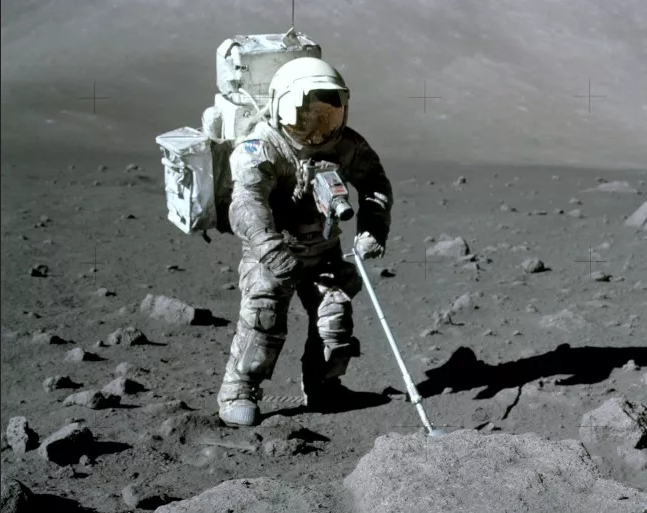
Credit: NASA
Lunar dust properties that must be addressed before any commercial presence on the Moon can be fully evaluated are:
1) abrasiveness and penetration, with regards to friction-bearing surfaces;
2) pervasive nature as coatings, on seals, gaskets, optical lens, windows, et cetera;
3) settling on all thermal and optical surfaces, such as solar cells; and
4) physiological effects on humans, especially with respect to the lungs, lymph system, and heart.
Review of Prior Dust Mitigation
A variety of solutions have been proposed to mitigate dust for future landed lunar missions that exploit some of the potential characteristics of lunar dust:
- Electrostatic curtains to repel charged dust particles, ionized by the incident solar VUV (V-UV, Vacuum Ultraviolet, Radiation whose spectrum runs between 100 and 300 nm).
- Magnets to attract dust containing Fe.
- Use of rechargeable sticky surfaces, similar to lint rollers to remove dust.
- Surface treatment to reduce dust stiction.
- Development of dust-resistant materials and seals, to keep the dust away from critical mechanisms and spacecraft modules.
Over the past decades, several dust mitigation technologies have been studied and developed. These technologies can be divided into four categories:
- fluidal methods,
Fluidal methods include using liquid jets, foams, and compressed gases to remove dust from the surfaces.
- mechanical methods,
Mechanical methods apply brushes (e.g., nylon bristles) or vibrating mechanisms to clean dust. The brushing technique has been used in the Apollo missions.
- electrodynamic methods and
Electrodynamics Dust Shield (EDS) has been extensively studied. The basic idea is to apply oscillating high-voltages on electrodes embedded beneath the surface of an equipment to shed dust. This technique is expected to be more efficient in the lunar environment because lunar dust is charged by solar wind plasma, solar radiation, and/or triboelectric effects.
- passive methods.
In passive methods, surfaces are modified (e.g., through ion implantation) to reduce the dust-surface adhesive force.
Literature Review on Dust Mitigation Strategies
Solar Wind Plasma, Solar Radiation, and/or Triboelectric Effects
The surface of the Moon is electrically charged by exposure to solar radiation on its dayside, as well as by the continuous flux of charged particles from the various plasma environments that surround it. An electric potential develops between the lunar surface and ambient plasma, which manifests itself in a near-surface plasma sheath with a scale height of order the Debye length.
Charged dust adhesion and transport on the Moon are strongly linked to the environmental electric fields. The lunar surface electrostatic potential can be calculated by balancing the incident electric currents to the Moon’s surface (i.e., in equilibrium the net current is zero). Using this approach it can be shown that the lunar dayside charges positive, as photoelectron currents caused by solar UV and X-rays dominate; and the lunar night side charges negative, since plasma electron currents dominate. It is also possible for the global-scale transition from positive to negative surface potential to occur dayside of the terminator.
Recently, dust shedding with plasma discharging was studied. It was demonstrated that dust was removed from a glass sphere exposed to a plasma with an electron beam. Shooting a plasma jet (1–2 kV) to dust-covered surfaces can effectively remove the dust. This plasma jet technique was originally developed for dust mitigation for exploration on the Martian surface which has a 4 Torr atmosphere that can be discharged to create a high-density plasma. The torr is a non-SI unit of pressure defined as 1/760 of standard atmosphere, Thus one torr is exactly 101325/760 pascals (≈ 133.32 Pa).
Work Function Matching Coating
A popular passive solution, which has been used in conjunction with EDS, is work function matching coating, which is an application of the space suit’s fabric material that matches the work function of the positively charged dust particles, effectively neutralizing the charge between the dust and the surface, decreasing the dust ability to stick to the surface.
PLZT Dust Removal
Other past solutions include PLZT dust removal, magnetic filters, and microwave radiation, which are all active mechanisms. The PLZT dust removal, or the photovoltaic effect of lanthanum-modified lead zirconate titanate, is an efficient mechanism that cleans solar panels via electrostatic traveling waves.
Dust Shedding Mechanism Utilizing an Electron Beam
Dust charging and lofting on surfaces in various plasma environments have attracted much attention over the past years. It has been shown that introducing an electron beam to a dusty surface can release dust particles from surfaces. Several theories have been developed to understand possible dust release mechanisms. However, none of them could fully explain the laboratory results. Recently, a series of new laboratory experiments and a simulation work have advanced the understanding of the fundamental mechanisms and characteristics of such electrostatic processes. It has been shown that dust particles can gain enough charge to be released from surfaces not only by being exposed to an electron beam but also by being exposed to ultraviolet (UV) light. Based on these new experimental discoveries, a new “patched charge model” has been developed by researchers. It is briefly described as follows. Dusty surfaces have a unique feature of microcavities forming between dust particles. When electrons or photons enter through a small gap and hit the blue surface patch of a dust particle below the top layer surface, secondary electrons or photoelectrons are emitted. A fraction of these emitted electrons is absorbed inside the microcavity and deposits negative charges on the surrounding dust particles (red patches). An enormously large electric field is formed across the cavity because of its small size (on the order of microns), resulting a buildup of substantial negative charges on the surrounding particles. The resulting repulsive force between these negatively charged particles is large enough to overcome the particle-particle cohesive or particle-surface adhesive force and the gravitational force, causing a release of these dust particles. It has been shown that single-sized dust particles up to 60 μm in diameter or aggregates as large as 140 μm in diameter can be released from surfaces under exposure to a 120 eV electron beam. In a recent study, the researchers performed a series of tests to find the optimized electron beam parameters to effectively shed dust off of surfaces.
Another technique is presented in a study to overcome the lunar dust problem, a unique cleaning system has been developed that uses electrostatic force to remove lunar dust adhering to the surfaces of equipment used for lunar exploration. A single-phase rectangular voltage is applied to insulated parallel electrodes printed on a flexible substrate to remove the dust using an electrostatic standing wave. This system is suitable for dust removal from flat areas such as the door of a Pressurized Excursion Module (PEM); however, it cannot prevent dust from entering into the clearance of bearings, mechanical seals, and gears of equipment. In fact, a mechanical seal is conventionally used for this purpose. An experiment demonstrated the performance of a spring-loaded Teflon seal in a vacuum environment. It showed good sealing ability for rotating shafts; however, a short lifetime and large braking torque are intrinsic problems with mechanical seals. Some other researchers are developing a brush-type seal made of Teflon fibers to mitigate these issues. It has been reported that the brush seal combined with a labyrinth seal has good sealing ability against the dust with a low braking torque; however, some amount of dust accumulates between the brush and the labyrinth seal, particularly during operation in a vacuum. Therefore, a short lifetime is a cause of concern for this method.
To overcome these problems, the researchers have developed a new electrostatic dust shield system for lunar dust as an additional countermeasure to mitigate the load on the mechanical shield and thereby improve the overall performance of mechanical equipment used for long-term lunar exploration. In their earlier system, a single-phase rectangular high voltage was applied to a pair of insulated parallel plate electrodes printed on a substrate at the clearance of the mechanical sealing part. It was demonstrated that more than 70% of the dust was repelled from the gap; however, because the performance of this system was not satisfactory, they have developed two improved systems that realize high sealing performance. The researchers describe the configuration and performance of the improved systems, which are expected to increase the reliability of equipment used in long-term manned and unmanned activities on the lunar surface.
An electrostatic shield system for lunar dust has been improved to prevent the dust from entering into the bearings, mechanical seals, and gears of equipment used for long-term lunar exploration. It was demonstrated that more than 90% of the dust was repelled from the clearance by adopting the combination of plate and screen electrode configuration. Direct observation of the motion of dust particles near the electrodes revealed that dust particles entering into the clearance were ejected through openings in the screen electrodes. A numerical calculation using the hard-sphere model of the 3D distinct element method confirmed the observed result, and it was predicted that the cleaning performance would be further improved in the low-gravity and vacuum environment of the Moon. Authors believe that the system is suitable for space applications because it is simple and lightweight and also because it does not have moving parts and requires extremely low power. Although the high performance was demonstrated and numerical calculations predicted further improvement in the low-gravity and vacuum environment of the Moon, it is not possible to achieve complete shielding, as small amounts of dust can still enter into the gaps. However, combining the proposed shielding device with other devices such as a mechanical seal and/or brush seal will increase the reliability of equipment used in long-term manned and unmanned activities on the lunar surface.
NASA’s Strategy to Deal with the Dust on the Moon
In 2019, NASA created the Lunar Surface Innovation Initiative (LSII) to come up with new technologies needed for future exploration of the Moon, with dust mitigation being one of the main priorities. The initiative came up with active and passive mitigation technologies for different kinds of equipment like rovers, power systems, spacesuits, and other types of hardware that NASA would send to the Moon. According to the dust shedding material program’s principal investigator at NASA Glenn, the combination of the passive and active techniques will allow the dust to be removed from the surface area while reducing the amount of power needed to remove it.
As mentioned earlier, dust from the Moon’s surface got into camera lenses, caused radiators to overheat, and even damaged the astronauts’ spacesuits. As NASA plans a human return to the Moon through the Artemis mission, the space agency is developing ways to mitigate the lunar dust so that it doesn’t interfere with equipment and ensure a more sustainable stay on the Moon.
NASA didn’t even realize they had a dust problem until they landed the first man on the Moon. The images from the Apollo mission revealed the damage caused by the dust. There was some of the equipment that overheated because the lunar dust prevented the heat from radiating away as it was supposed to and mechanical clogging of equipment. When astronauts were entering and exiting the lunar module, the dust got everywhere – it interfered with instruments and even tore up their spacesuits. Fifty years later, the challenges of dust are greater for long-term exploration and sustainability on the Moon, as well as future human exploration of Mars.
Some of the ideas that are currently being developed include an ion-beamed deposited coating or laser patterned surfaces. The team has started developing these materials and testing them in the lab, experimenting with different textures and combinations. NASA is then planning on testing these experimental solutions on the surface of the Moon starting in 2023.
The solutions NASA is working on are called ‘leave no damage behind’ types of solutions. These are things that will only affect the equipment and prevent the equipment from being damaged by the dust, but will not do anything specifically to change what is on the Moon. The solutions are not only for missions like Apollo but are designed for a longer, more sustainable stay on the Moon as NASA plans on building a lunar base on the Moon.
NASA Kennedy to Develop Tech to Melt Moon Dust
A team at NASA’s Kennedy Space Center in Florida is planning to develop a device that will melt lunar regolith and turn it into oxygen. Advancing technologies to use space-based resources is important to sustainable lunar exploration under the agency’s Artemis program and will support future exploration into the solar system, including Mars.
The Gaseous Lunar Oxygen from Regolith Electrolysis (GaLORE) project team won an internal award to develop the melting technology. Regolith on the Moon is made from oxidized metals like iron oxide, silicon oxide, and aluminum oxide. GaLORE is advancing technology to heat the regolith to more than 3,000 degrees Fahrenheit (1649 degrees Celsius) and flow electricity through the molten material. This will cause a chemical reaction that splits the regolith into gaseous oxygen and metals.
NASA needs technologies that use lunar materials to achieve our secondary goal — sustainable human lunar exploration — to prepare for long-duration human missions to Mars.
Dust Mitigation Projects
The Space Technology Mission Directorate is funding a variety of dust mitigation projects to enable the integrated dust mitigation strategy. The projects listed below will ensure that existing active and passive technologies are mature and can potentially be infused into the various architecture elements.
- Patch Plate Materials Compatibility Assessment. A number of heritage and new spaceflight materials should be extensively tested in the lunar environment to understand both how the materials change with time and how regolith adheres to the surfaces. A microscope and dust sensor addition to this passive experiment will greatly improve the science retrieved from this passive payload.
- Lunar Demonstration of Electrodynamic Dust Shield. A mature active dust removal technology that uses electric fields to remove dust from surfaces. This technology can be integrated into optical systems and thermal systems. This technology is currently undergoing technology demonstration on the International Space Station.
- Dust Tolerant Mechanisms Testing. Rovers and other architecture elements will have rotary joints for steering, suspension, and drive actuators. These joints will be subjected to a dusty lunar environment. This work will enable better rotary joint design for small and large architecture elements.
- Lunar Dust Mitigation Best Practices Guide. Many architecture elements are in need of a guide to design dust mitigation for mechanisms, optics, and many other applications. This ‘Best Practices’ guide will call on experience in previous NASA projects, experiences in military operations, and industry knowledge.
Other dust mitigation investments and activities are being coordinated through Small Business Innovative Research, NASA’s Human Exploration and Operations Mission Directorate, and NASA’s Science Mission Directorate.
Research study on regolith sintering proposes an interim solution, consisting of constructing a thin in situ pavement similar to an airport tarmac in the contiguous area where large-scale observatories are maintained – thus preserving a necessary clean haven for science. The measure scales up in the sense that the same surface-blanket functions as the subfloor for subsequent tiling with thin-layered bricking tiles produced by regolith sintering, although that may not be necessary. A critical step in the concept is the use of epoxy and hydrogen.
Regolith Sintering: Sintering is the bonding of particles below the melting temperature, causing particles to cross-grain boundaries by means of temperature and pressure. Sintering of the lunar regolith has been discussed at some length as a method for producing construction materials from in situ resources at a lunar base.
Electron Showers
Electron beams offered a promising solution. According to a theory developed from recent scientific studies of how dust naturally lofts on the lunar surface, such a device could turn the electric charges on particles of dust into a weapon against them. If you hit a layer of dust with a stream of electrons, that dusty surface will collect additional negative charges. Pack enough charges into the spaces in between the particles, and they may begin to push each other away — much like magnets do when the wrong ends are forced together. The charges become so large that they repel each other, and then dust ejects off of the surface.
To test the idea, a vacuum chamber was loaded with various materials coated in a NASA-manufactured “lunar simulant” designed to resemble moon dust. And sure enough, after aiming an electron beam at those particles, the dust poured off, usually in just a few minutes. The trick worked on a wide range of surfaces, too, including spacesuit fabric and glass. This technology aims at cleaning the finest dust particles, which are difficult to remove using brushes. The method was able to clean dusty surfaces by an average of about 75-85%.
Shoot for the Moon is a project by Space Systems Design Lab and the Center for Space Technology And Research (CSTAR) team at Georgia Tech. They are working on a hybrid dust mitigation brush that utilizes an electrodynamic system (EDS) and ultraviolet (UV) technology to prevent dust collection on lunar spacesuits. The hybrid brush will use a removable EDS bristle cartridge that astronauts can easily glide on their spacesuits. The brush design uses a mix of charged bristles and non-charged bristles. After astronauts have used the hybrid brush on their suits, the remaining particles are removed by using the UV light to charge them and then brushed off. The team hopes that the brush will remove more than 90 percent of dust from spacesuits and other applicable surfaces.
Breakthrough, Innovative and Game-changing (BIG) Idea Challenge
Through its annual Breakthrough, Innovative, and Game-changing (BIG) Idea Challenge 2020, NASA was looking for a wide range of creative solutions from college and university students on the theme of lunar dust mitigation. Categories under the theme included dust prevention and mitigation during landings, spacesuit dust tolerance, exterior dust clean-up, and controlling lunar dust within habitats. Competition judges were going select between five and 10 teams to receive up to $180,000 each to build, test, and demonstrate robust lunar dust mitigation, or dust tolerant capabilities and technologies. Seven university-affiliated groups were finally selected for funding.
Rhode Island School of Design (RSID Space Design club) developed technology that uses densely packed fibers that are electrostatically charged to repel the dust. The original thought was to apply the technology to space suits, but early feedback from NASA engineers suggested that the tech would need to be tested in a lower-stakes arena first, perhaps as part of a camera lens or battery cover that traveled to space.
The Caltech team’s invention, named Habitat Orientable & Modular Electrodynamic Shield (HOMES), tackles the problem of moon dust entering a potential lunar habitat and wreaking havoc within. HOMES is a modular system of square tiles about the thickness of an iPhone that can be arranged into a flat surface. The tiles make up an electrodynamic dust shielding (EDS) system. Wires embedded within the tiles create an electrical field that extends like a forcefield across the tiles’. The dust particles carry an electrical charge given to them by rays from the sun, so the electrical field on the tiles repels them. Thus, by varying or alternating the current in the wires, or by changing the orientation of the tiles, a user can tailor the electric field to move the dust in a controlled way.
HOMES could be on the floor of a changing room in an airlock, and any dust that falls to the floor can then be transported to a singular zone because it can orient the panels to move the dust in a specified direction, that would allow astronauts to much more easily clean a pile of dust instead of it being spread over the entire room.
A team of Colorado School of Mines students received funding from NASA to develop lunar dust mitigation solution. The Mines team is collaborating with three industry partners – ICON, Masten Space Systems, and Adherent Technologies Inc. – on their project, a dust-busting landing pad that could be rolled out like a red carpet for arriving spacecraft.
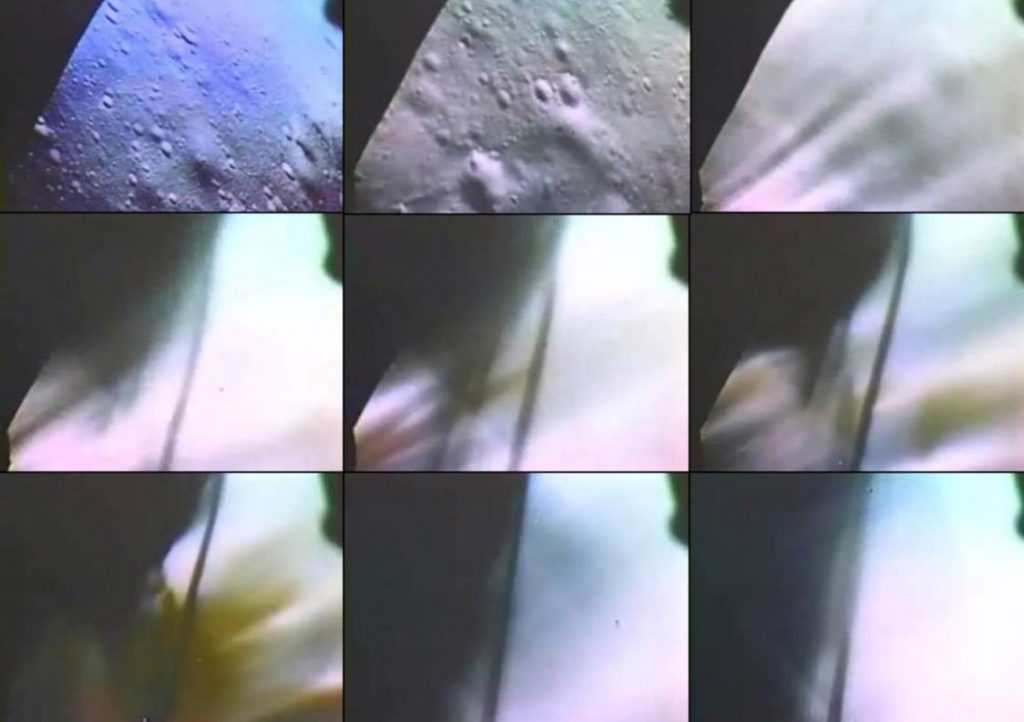
Source: NASA’s Apollo 15 landing video, converted by Gary Neff
The Lunar In-Situ Landing/Launch Environment Pad, or LILL-E Pad, consists of two parts: A carbon fiber fabric landing “pad” that is anchored to a larger “POND” of polymer-reinforced regolith. The inspiration for LILL-E Pad came from the U.S. Marine Corps, which uses a similar lightweight blanket when landing helicopters in dusty desert environments.
Carbon fiber is lightweight and resistant to heat, basic carbon fiber fabric – can be rolled out like a blanket and can land the craft on it, trapping the regolith beneath. That center “pad”, with a 25-meter radius, would sit in the middle of a 100-meter radius “pond”, created by laying down a specialized polymer to harden the regolith and further mitigate dust.
Another project for NASA’s big idea challenge is proposed for mitigation and prevention of Lunar Dust on NASA Artemis xEMU Spacesuits. The proposed final solution consists of an electrode sleeve that can be rapidly integrated into the surface of xEMU space suits that are prone to the highest level of lunar dust accumulation. These areas include the upper arms, forearms, thighs, and calves, as the most vulnerable areas of the spacesuit to lunar dust contamination.
The sleeves are to be constructed of a high elasticity ortho-fabric similar to the existing outer layer of NASA xEMU suits. The EDS mesh will be sewed into the fabric in a grid structure using 0.3 mm (0.01 in) gaps between adjacent electrodes (as derived in the Power Calculations for EDS section). The electrodes could potentially be enameled copper wire or carbon nanotube thread. Both materials serve as effective electrodes, but each carries drawbacks. Additionally, a segmented and fastenable solution utilizing multiple sleeves was selected in order to avoid stress in the electrodes, improve ease of use, mitigate poor adhesion between each end of the sleeve, and avoid modifying any fabric layers of the existing xEMU suits. Furthermore, the reason the electrodes were chosen to span along the length of the sleeves in a patterned hoop-like configuration was to ensure that the rails for either set of electrodes were adjacent to one another. This would ensure that the wires providing the AC signal to the rails can be coupled through some physical means of fastening, therefore reducing the risk of entanglement or wire strain.
Chang’E-3 Mission
China designs a highly sensitive lunar dust detector (LDD) attempting to investigate dust deposition property induced by the landing of the lunar lander in Chang’E-3 mission with an altitude of 205 cm over the lunar surface, that is to say, this instrument makes effort to assess the amount of lunar dust that may be expected to accumulate on LDD as a result of lander landing in Chang’E-3 mission. Chang’E-3 lunar dust detector (LDD), a high-performance dust instrument, is composed of two parts: solar cell probe (SCP) acts as sensor head and its corresponding electronic box that includes A/D circuit, communication circuit, control circuit, and storage circuit.
Japanese SELENE-2 Project
ESA is working with the Canadian and Japanese space agencies to prepare the Heracles robotic mission to the Moon in the mid-to-late-2020s. Using the space Gateway as a halfway point, a robotic rover will scout the terrain in preparation for the future arrival of astronauts, and deliver lunar samples to Earth.
SELENE-2 project has been started in 2007 as the first Japanese lunar lander. The main prior object of the SELENE-2 mission is to develop a safe and precise landing system on the middle to large planets and satellites such as the Moon, Mars for future lunar and planetary exploration. Other key technologies under investigation are surface mobility by a rover and long night survival module without using nuclear power.
Key technologies for exploration:
- Safe and precise landing technologies
- Surface mobility: robotic rover
- Long mission life: Night survival technologies
In-situ activities for science and lunar utilization:
- Detailed geology & Geophysics for Lunar interior structure
- Measure dust, radiation, soil environment
Contribution to international lunar activity and public interest:
- International payload (To Be Determined by JAXA Space Exploration Center)
- Outreach payload (To Be Determined by JAXA Space Exploration Center)
Measuring Dust
It is necessary to make targeted in-situ measurements of dust-plasma surface interactions on the Moon in order to fully understand this alien environment. This will be an important precursor to human exploration, which will allow our new understanding to be applied to the development of systems and equipment, particularly critical systems such as life support.
Future necessary measurements include:
– Determining the size and concentration of dust in the lunar exosphere. This will reveal exactly how much dust gets ejected from the surface.
– Finding the surface electric field height profile. This will reveal both the surface potential and the shielding scale length (Debye length). The surface electric field is a driver behind the electrostatic transport of dust. Observations can be correlated with upstream conditions (e.g., in the solar wind) to determine their effect on surface charging.
– Direct detection of the mass, velocity, and charge of dust grains above the surface. A future instrument will need to be sensitive to grains with energies below the threshold of the Lunar Ejecta and Meteorites (LEAM) since this will likely allow the detection of the bulk of the transported dust population.
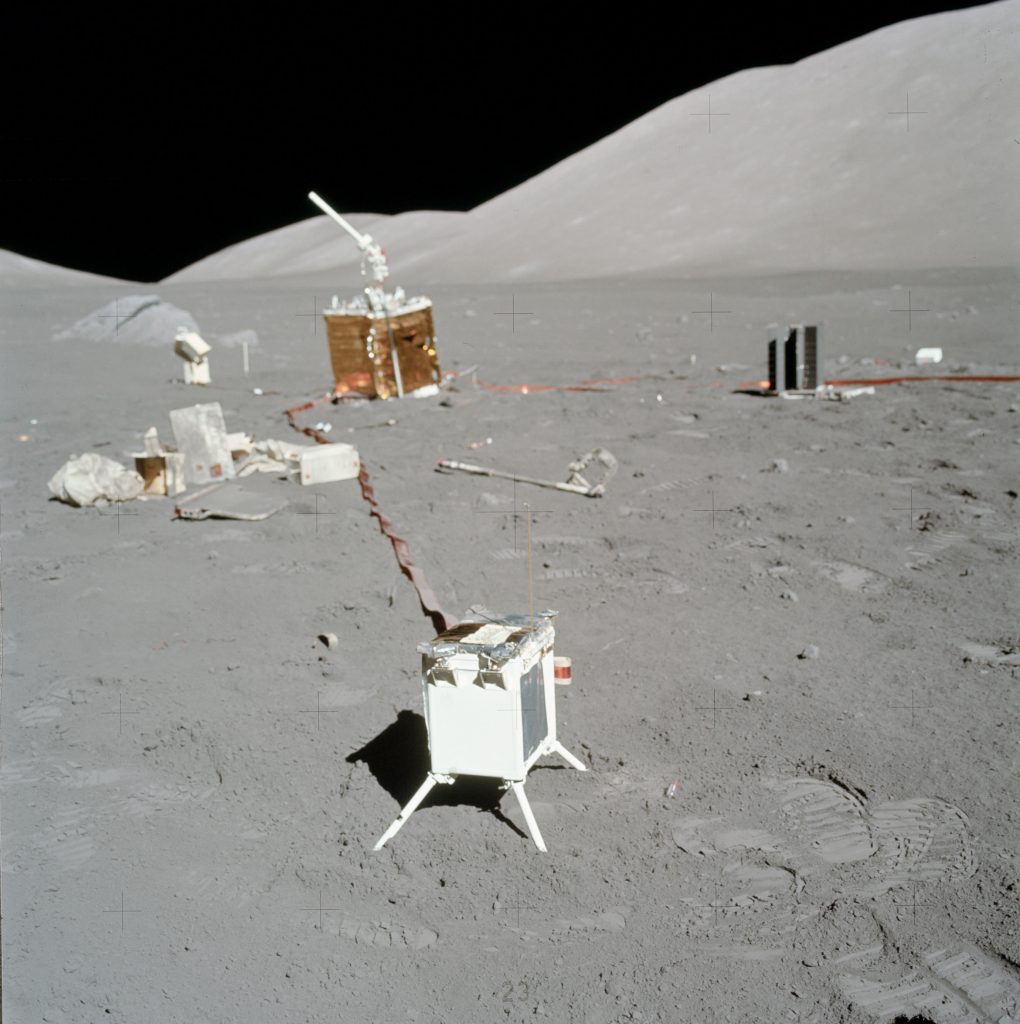
Credit: NASA
Following instruments can be used to measure the key dust-plasma parameters:
| Measurement | Instrumentation |
|---|---|
| Exospheric dust concentrations | Photometer (passive) CCD imager with filters (passive) LiDAR (active) |
| Surface electric fields | Electric fields boom (and maybe magnetometer) |
| Dust mass, velocity, and charge | Microphone-type impact sensor (similar to LEAM) |
| Plasma characteristics | Electron spectrometer, Ion mass spectrometer |
NASA’s Next Space Technologies for Exploration Partnerships (NextSTEP) program issued a series of documents detailing specific needs for a future lunar habitation and inviting private industry to help overcome obstacles to future lunar missions. One of these needs was for air revitalization and monitoring, including a way to measure lunar dust in surface and orbiting habitats.
Lunar Outpost Inc. was founded in Denver in 2017 with the goal of developing technologies for lunar exploration and then adapting them for use on Earth. Based on the specifications laid out in NextSTEP documents, the company developed an air-quality sensor called Canary-S (previously the Space Canary). Canary-S can detect the ultra-fine lunar dust particles inside a habitat and be used on Earth for measuring forest fire emissions, evaluating air quality, and more.
Lunar Outpost offered the sensor to Lockheed Martin Space, which was one of several companies to successfully bid on a NextSTEP public-private partnership to build lunar orbit habitat prototypes for testing. Lockheed agreed, bringing Lunar Outpost on as a contributor to tweak the Canary-S sensor to NASA’s needs.
Dust Problems Caused by Rocket Exhaust
The Moon is a low-gravity and airless body, which makes the rocket plume effects very different than what we experience on Earth. The dust can cause severe damage to the surfaces of materials if astronauts land too close to other hardware on, or orbiting, the Moon. Lunar lander engine exhaust blows dust, soil, gravel, and rocks at high velocity and will damage surrounding hardware — such as lunar outposts, mining operations, or historic sites — unless the ejecta are properly mitigated.
The scientist and other team members at UCF’s Center for Lunar and Asteroid Surface Science (CLASS) say landing pads are needed for missions that repeatedly visit a lunar outpost. For lunar landings, CLASS research has shown that the sandblasting that will occur at a lunar outpost is unacceptable, as it will excessively degrade optics, solar cells, thermal control surfaces, and moving joints on mechanisms. The impacts of blowing rocks could also break hardware.
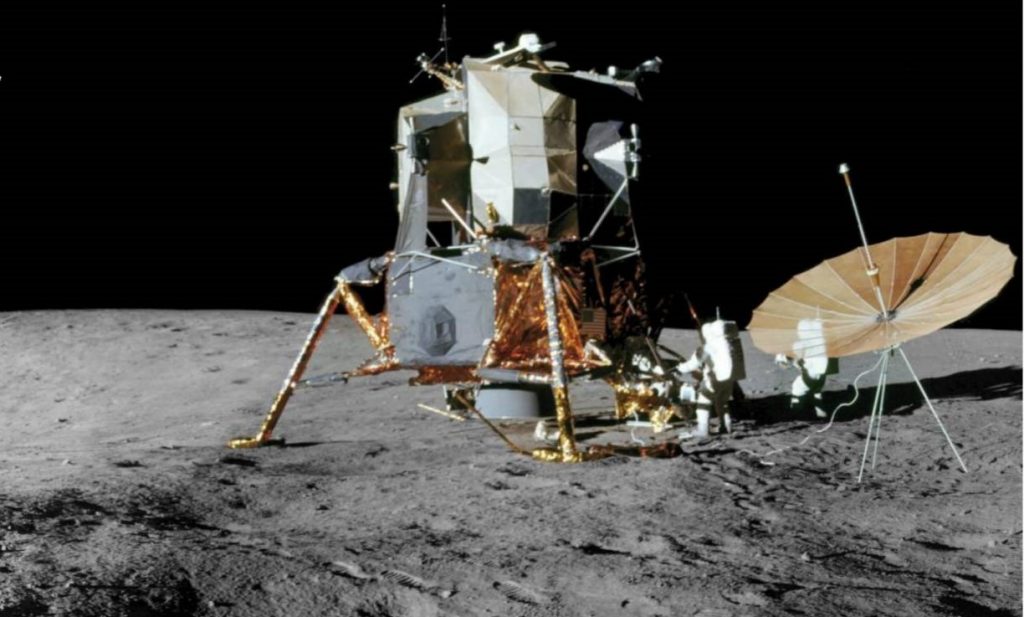
Credit: NASA
Florida Space Institute researchers are investigating methods to mitigate the effects of these blasts, such as sintering lunar regolith. They’re also looking at robotics for bulldozing and building berms, as well as considering the use of gravel or pavers. And they’re organizing a series of robotics competitions for landing pad construction technologies in conjunction with machine learning firms to further advance the necessary robotics capabilities.
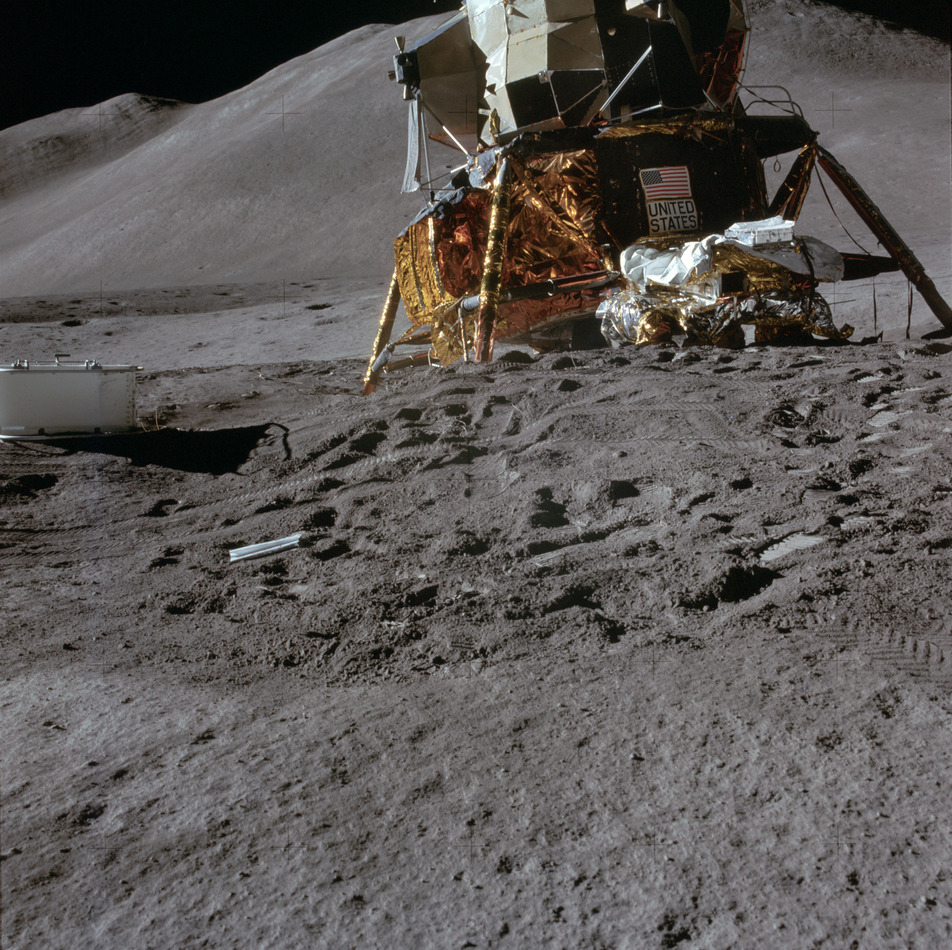
Credit: NASA
Future human landers will have more issues with plume effects than Apollo landers because of higher engine thrust. NASA researchers are developing concepts for lunar landing and launchpads for crewed landers as well. The space agency is currently taking steps to evaluate the potential effects in a lunar vacuum environment, with new computer modeling codes that have been under development through NASA’s Small Business Innovation Research and Small Business Technology Transfer programs.
Protecting Equipment from Lunar Dust
Contamination with lunar dust may affect equipment and instrumentation and for example, cause degradation of seals and valves and cause a breakdown of lubricants, jam moving parts and create flow blockages. During the Apollo 12 mission, the landing velocity trackers gave false readings. Landing radar outputs were affected by moving dust and debris during landing together with visual obscuration. In every Apollo mission, there was clogging of camera equipment, lock buttons, etc. together with thermal control problems due to an insulating layer of dust on the radiator surfaces. It is vitally important that these issues are controlled during a mission by ensuring that little dust enters the craft. This could be achieved by a combination of cleaning suits and equipment whilst on the ladder waiting to return, by using floors with sticky peel, by using magnetic coats to remove any residual dust, by providing suitable airlock decompression and vacuum cleaning within the airlock and near the platform at the top of the ladder, by using more brushing and by providing adequate filtration for 0.1 lm particles in the airlock and cabin. The measures instigated to protect hardware from dust contamination should protect all direct openings to the cabin, provide protection for depressurization and re-pressurization valves, and to provide a high-recirculation rate air clean up with high-speed fans and high-efficiency particulate filters (HEPA). Furthermore, the craft should be so designed that there are few cavities and crevices in the floor space where dust could accumulate and later cause a health problem. Also brushing by itself will not be fully effective at removing dust and will be time-consuming.
Prevention
All support equipment for a moon base that has the possibility of being exposed to the lunar environment, directly or indirectly, must consider the existence of the lunar dust in its design. Although removal may not be required in some cases, the cleaning task will play a major role in the allocation of crew time and equipment maintenance if prevention measures are not taken. In addition, many items are difficult to clean due to their geometry, scale, surface properties, operating condition, and location. Also, the safety of the crew should not be dependent on the regular performance of lunar dust removal from equipment and surfaces.
Prevention alternatives exist in both hardware and operation design for all systems exposed to the lunar dust. Areas of particular interest are large surface areas (solar arrays, thermal radiators), optical equipment (windows, lenses, mirrors), extravehicular mobility unit (spacesuit, portable life support), mechanical systems (lunar rovers, robotics), interfaces (tools, connectors).
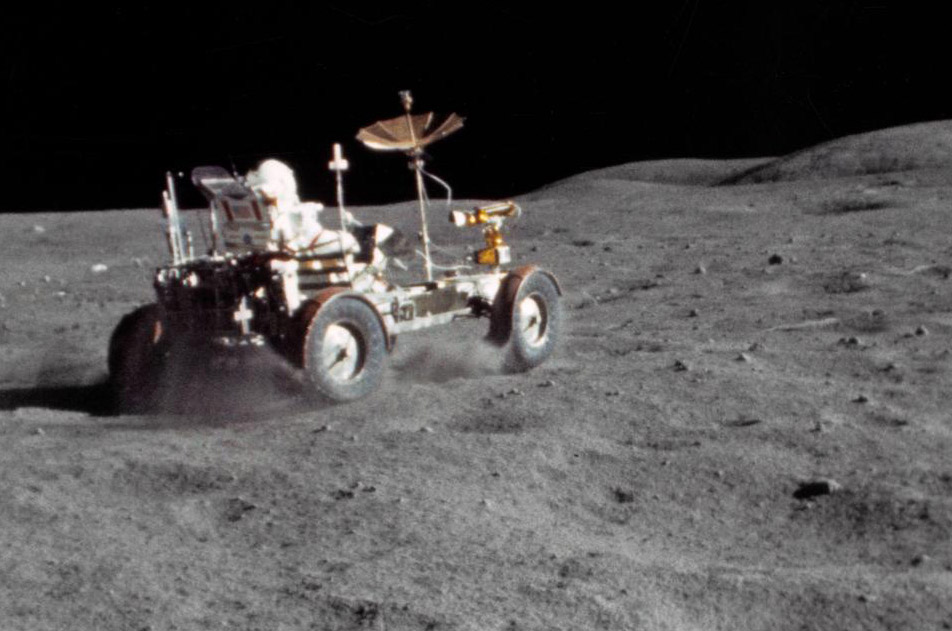
Credit: NASA
Mechanical Systems
A variety of mechanical systems will be exposed to the lunar dust environment. Equipment such as manned and autonomous lunar rovers and robotic systems will present the difficulty of keeping lunar dust from abrading critical moving parts. Fortunately, mechanical systems have been tested in previous lunar experiences; for instance, the Apollo lunar rover. Beyond sealing critical moving parts, the true challenge of prevention will be in preparation for maintenance. The area of primary concern is the interfaces that must be mated and unmated during maintenance in the lunar environment.
JAXA is developing new sealing technology to protect equipment from lunar dust. Seals prevent leakage of liquids and gas from within the equipment and also prevent external foreign substances such as dust and fine sand from entering into the equipment. Seals used on lunar rovers must be optimized for the lunar environment, in order to prevent the intrusion of regolith into key components of the rover or the equipment loaded onto it. Moreover, the rovers need to have the sturdiness to remain in operation even when moving over the regolith, and must also be energy efficient so that they can operate with a limited amount of electric power.
Heat rejection from power systems will be necessary for human and robotic activity on the lunar surface. Functional operation of such heat rejection systems is at risk of degradation as a consequence of dust accumulation. Perhaps the most instructive lessons learned from Apollo on the effects of lunar dust on heat rejection system surfaces come from the radiators that cooled the batteries of the rover.
Dust Mitigation for NASA’s VIPER
As we know this dust can gum up electronics and stop them from working, NASA has been searching for solutions and recently announced a strategy for dealing with the dust when it comes to its newest lunar rover, the Volatiles Investigating Polar Exploration Rover, or VIPER, which will hunt for water on the Moon from 2023 ahead of the arrival of Artemis astronauts. One of the challenges for VIPER is that the engineers aren’t sure what type of dust it will encounter — whether it will be light and fluffy or compacted and heavy. Therefore, the rover is designed to be highly maneuverable, able to drive sideways and diagonally, and this agility means it can cope with different surfaces.
To test out dust protection, the engineers took one of the rover’s wheels and placed it in a “dust chamber,” an open-topped acrylic box that is full of simulated dust and fans to blow it about. The wheel was protected by a flexible covering which acts as heat insulation and dust protection, then the fans were turned on and moved to simulate the worst possible conditions for dust.
Once the test was over, the engineers found that there was dust all over the outer covering, but none had managed to penetrate to the inside of the rover wheel. This suggests that the covering may be effective at protecting the delicate electronics inside the rover from abrasive dust. As further protection against dust, the team is also testing out various different types of seals for the wheels’ electrical motors.
Mitigating Electrical Build-Up
The idea was to use an advanced technology called atomic layer deposition to apply super-thin films of indium tin oxide — an effective compound for dissipating electrical charges — onto dry pigments of paint. Once mixed, the paint could then be coated on radiators and other spacecraft components to help mitigate the build-up of electrical charges.
Used ubiquitously by industry, atomic layer deposition involves placing a substrate or sample inside a reactor chamber, which is like an oven, and pulsing different types of gases to create an ultra-thin film whose layers are literally no thicker than a single atom. The beauty of this technique is the fact that it can be applied to virtually anything, including three-dimensional objects.
To test the effectiveness of the pigment-treated paint, researchers then prepared a handful of coated coupons or wafers, which are now being exposed to plasma from an experiment pallet aboard the International Space Station.
Summary
Future machinery on the Moon will be presented challenges. Unlike other equipment and instruments that operate on the Moon, In-Situ Resource Utilization (ISRU) systems and hardware need to operate continuously and in direct contact with lunar regolith and dust for very long periods of time. It is vital to develop techniques and technologies to resist abrasion, safeguard optical coatings, as well as protect rotating mechanisms. The problem of the lunar dust is not well-appreciated but is of paramount importance for any considerations of commercialization of the Moon relative to resource recovery, engineering design, operational procedures planning, and occupational medical practice. The liabilities from lunar dust can be mitigated and potentially eliminated by using the unique features of the dust and the developed techniques. Lunar dust is a real challenge to lunar surface operations, while also being of great scientific interest. The lunar surface provides an almost infinite source of dust. Lunar surface operations will most likely require a combination of dust mitigation strategies; from minimization of agitation of the dust to local protection of devices and personnel. In particular, measurements and experiments need to be taken and conducted on the lunar surface by precursor landers to ascertain dust characteristics that will influence hardware design, and provide toxicology data to safeguard crew health.

